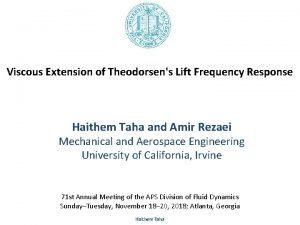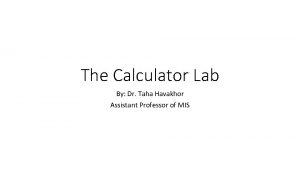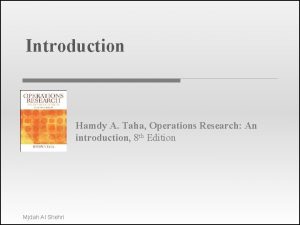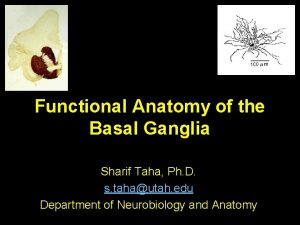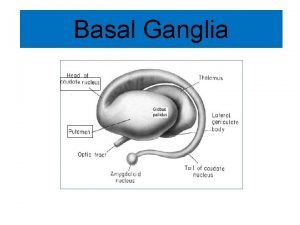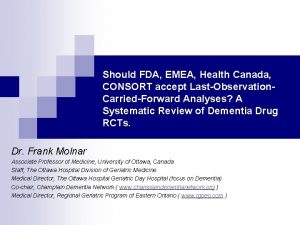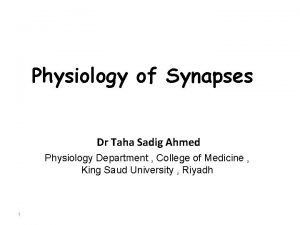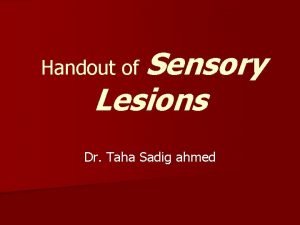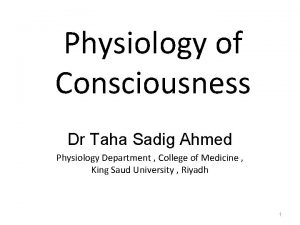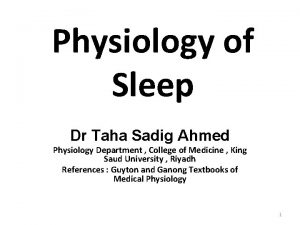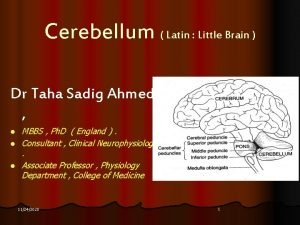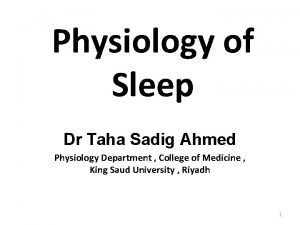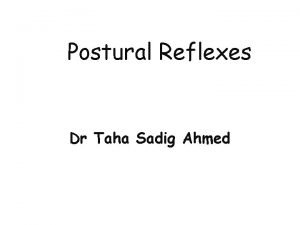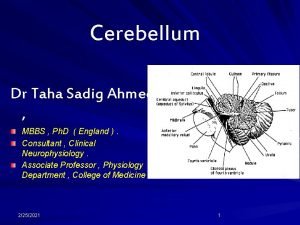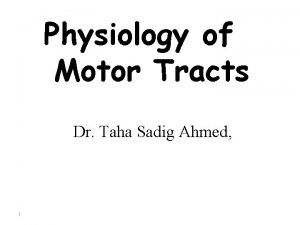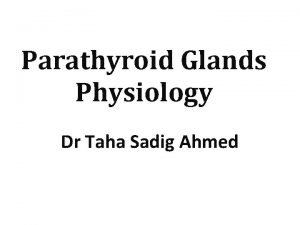Pathophysiology of Epilepsy Dr Taha Sadig Ahmed Definition














- Slides: 14

Pathophysiology of Epilepsy Dr Taha Sadig Ahmed

Definition of seizure and Epilepsy • Seizures are symptoms of a disturbance in brain function , which can be due to epilepsy or other causes. • A seizure is a sudden surge in electrical activity in the brain that causes an alteration in sensation, behavior, or consciousness • They result from abnormal , excessive electrical discharge of a group of neurons within the brain. • Epilepsy is a group of diseases characterized by recurrent, unprovoked seizures. • Therefore , when a person has recurrent ( 2 or more) , unprovoked seizures we can label him “ epileptic “. • Hence seizures can be a symptom of epilepsy. • While epilepsy is a disease, the terms seizure and epilepsy should not be used interchangeably.

• Seizures are classified as partial or generalized by the origin of the seizure activity and associated clinical manifestations. • a. Simple partial seizures manifest motor, somatosensory, and psychomotor symptoms without impairment of consciousness. • b. Complex partial seizures manifest impairment of consciousness with or without simple partial symptoms. Partial psychomotor (temporal lobe) seizure • Epileptic seizures which originate in the temporal lobe of the brain. • The seizures involve sensory changes, for example smelling an unusual odour that is not there, and disturbance of memory. • Auditory or visual hallucinations, déjà vu • The most common cause is mesial temporal sclerosis

• c. Generalized seizures manifest a loss of consciousness • Generalized seizures can be convulsive ( accompanied by convulsions ) or non-conculsive ( not accompanied by convulsions ). • Generalized seizures include • (1) generalized tonic-clonic seizures , ( GTC ), formerly called Grand Mal epileptic seizure ) and • (2) Absence seizures( formerly called Petit mal epileptic seizures • GTC are convulsive and Absence are nonconvulsive.

• Simple partial seizures can progress to complex partial seizures, and complex partial seizures can secondarily become generalized. • Seizures affect all ages. Most cases of epilepsy are identified in childhood, and several seizure types are particular to children.

Seizure Classification & Clinical Manifestations 1. 2. Focal / Partial seizures their onset ( start) is limited to part of the cerebral hemisphere Generalized seizures those that involve the cerebral cortex diffusely ( whole of it ) from the beginning (generalized seizures


• The onset of a seizures appears to occur when a small group of abnormal neurons undergo prolonged depolarizations associated with the rapid firing of repeated action potentials. • These abnormally discharging epileptic neurons recruit adjacent neurons or neurons with which they are connected into the process. • A clinical seizure occurs when the electrical discharges of a large number of cells become abnormally linked together, creating a storm of electrical activity in the brain. • Seizures may then spread to involve adjacent areas of the brain or through established anatomic pathways to other distant areas.

• Generalized tonic-clonic (grand mal) seizure • a. May be preceded by an aura such as a peculiar sensation or dizziness; then sudden onset of seizure with loss of consciousness. • b. Rigid muscle contraction in tonic phase which clenched jaw and hands; eyes open with pupils dilated; lasts 30 to 60 seconds. • c. Rhythmic, jerky contraction and relaxation of all muscles in clonic phase with incontinence and frothing at the lips; may bite tongue or cheek, lasts several minutes. • d. Sleeping or dazed postictal state for up to several hours.

• 2. Absence ( petit mal) seizure ( are Generalized Seizures) • a. Loss of contact with environment for 5 to 30 seconds. • b. Appears to be day dreaming or may roll eyes, nod head, move hands, or smack lips. • c. Resumes activity and is not aware of seizure .

• The clinical manifestations of a seizure reflect the area of the brain from which the seizure begins (i. e. , seizure focus) and the spread of the electrical discharge. • Clinical manifestations accompanying a seizure are numerous and varied, including • (1) indescribable bodily sensations, • (2) "pins and needles" sensations, • (3) smells or sounds, • (4) fear or depression, • (5) hallucinations, • (6) momentary jerks or head nods, • (7) staring with loss of awareness, and • (8) Convulsions i. e. , involuntary muscle contractions) lasting seconds to minutes.

Pathophysiology of Epilepsy ( at molecular level) • At the cortical cell membrane level, in epileptic patients , certain biochemical phenomena characterize the epileptogenic focus , including : Ø Instability of the nerve cell membrane Polarization abnormalities (excessive polarization , hypopolarization , or lapses in repolarization), allowing the cell to be more susceptible to activation Hypersensitive neurons with lowered thresholds for firing and firing excessively , related to § (1) Excess of Excaitatory ( acetylecholine- or Glutamate – related activity ) § (2) Decreased inhibitory ( GABA –related activity) Ø Together and/or (2) above leading to instability of cellmembrane & lowered threshold for exciatation excessive polarization, hypopolarization allowing the cell to be more susceptible to activation spontaneously or by any ionic imbalances in the immediate chemical environment of neurons.

• • • Ø Ø • Electroencephalogram ( EEG) EEG is helpful for establishing the diagnosis, classifying seizures correctly, and making therapeutic decisions In combination with appropriate clinical findings, epileptiform EEG patterns termed spikes or sharp waves strongly support a diagnosis of epilepsy EEG in patients with seizures : focal epileptiform discharges indicate focal epilepsy generalized epileptiform activity indicates a generalized form of epilepsy. • Most EEGs are obtained between seizures, and interictal abnormalities alone can never prove or eliminate a diagnosis of epilepsy • Epilepsy can be definitly established only by recording a characteristic ictal discharge during a clinical attack.

• Some types of epilepsy have been traced to an abnormality in a specific gene. Many other types of epilepsy tend to run in families, which suggests that genes influence the brain disorder. • it is increasingly clear that for many forms of epilepsy, genetic abnormalities play only a partial role, perhaps by increasing a person's susceptibility to seizures that are triggered by an environmental factor. • Several types of epilepsy have now been linked to defective genes for ion channels, the "gates" that control the flow of ions in to and out of cells and that regulate neuron signaling. • Example : Lafora's disease, has been linked to a gene that helps to break down carbohydrates.


